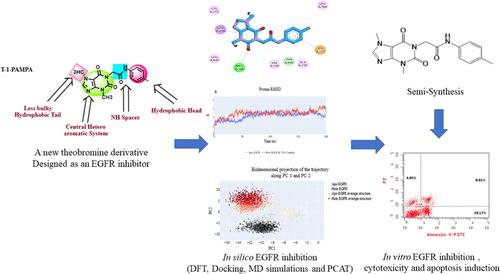Our official English website, www.x-mol.net, welcomes your feedback! (Note: you will need to create a separate account there.)
New Theobromine Apoptotic Analogue with Anticancer Potential Targeting the EGFR Protein: Computational and In Vitro Studies
ACS Omega ( IF 4.1 ) Pub Date : 2024-03-27 , DOI: 10.1021/acsomega.3c08148 Ibrahim H. Eissa 1 , Reda G. Yousef 1 , Eslam B. Elkaeed 2 , Aisha A. Alsfouk 3 , Dalal Z. Husein 4 , Ibrahim M. Ibrahim 5 , Ahmed Ismail 6 , Hazem Elkady 1 , Ahmed M. Metwaly 7, 8
ACS Omega ( IF 4.1 ) Pub Date : 2024-03-27 , DOI: 10.1021/acsomega.3c08148 Ibrahim H. Eissa 1 , Reda G. Yousef 1 , Eslam B. Elkaeed 2 , Aisha A. Alsfouk 3 , Dalal Z. Husein 4 , Ibrahim M. Ibrahim 5 , Ahmed Ismail 6 , Hazem Elkady 1 , Ahmed M. Metwaly 7, 8
Affiliation

|
Aim: The aim of this study was to design and examine a novel epidermal growth factor receptor (EGFR) inhibitor with apoptotic properties by utilizing the essential structural characteristics of existing EGFR inhibitors as a foundation. Method: The study began with the natural alkaloid theobromine and developed a new semisynthetic derivative (T-1-PMPA). Computational ADMET assessments were conducted first to evaluate its anticipated safety and general drug-likeness. Deep density functional theory (DFT) computations were initially performed to validate the three-dimensional (3D) structure and reactivity of T-1-PMPA. Molecular docking against the EGFR proteins was conducted to investigate T-1-PMPA’s binding affinity and inhibitory potential. Additional molecular dynamics (MD) simulations over 200 ns along with MM-GPSA, PLIP, and principal component analysis of trajectories (PCAT) experiments were employed to verify the binding and inhibitory properties of T-1-PMPA. Afterward, T-1-PMPA was semisynthesized to validate the proposed design and in silico findings through several in vitro examinations. Results: DFT studies indicated T-1-PMPA’s reactivity using electrostatic potential, global reactive indices, and total density of states. Molecular docking, MD simulations, MM-GPSA, PLIP, and ED suggested the binding and inhibitory properties of T-1-PMPA against the EGFR protein. The in silico ADMET predicted T-1-PMPA’s safety and general drug-likeness. In vitro experiments demonstrated that T-1-PMPA effectively inhibited EGFRWT and EGFR790m, with IC50 values of 86 and 561 nM, respectively, compared to Erlotinib (31 and 456 nM). T-1-PMPA also showed significant suppression of the proliferation of HepG2 and MCF7 malignant cell lines, with IC50 values of 3.51 and 4.13 μM, respectively. The selectivity indices against the two cancer cell lines indicated the overall safety of T-1-PMPA. Flow cytometry confirmed the apoptotic effects of T-1-PMPA by increasing the total percentage of apoptosis to 42% compared to 31, and 3% in Erlotinib-treated and control cells, respectively. The qRT-PCR analysis further supported the apoptotic effects by revealing significant increases in the levels of Casp3 and Casp9. Additionally, T-1-PMPA controlled the levels of TNFα and IL2 by 74 and 50%, comparing Erlotinib’s values (84 and 74%), respectively. Conclusion: In conclusion, our study’s findings suggest the potential of T-1-PMPA as a promising apoptotic anticancer lead compound targeting the EGFR.
中文翻译:

具有针对 EGFR 蛋白的抗癌潜力的新型可可碱凋亡类似物:计算和体外研究
目的:本研究的目的是利用现有 EGFR 抑制剂的基本结构特征作为基础,设计和检验一种具有凋亡特性的新型表皮生长因子受体 (EGFR) 抑制剂。方法:研究从天然生物碱可可碱开始,开发出一种新的半合成衍生物(T-1-PMPA)。首先进行计算 ADMET 评估,以评估其预期安全性和一般药物相似性。最初进行深密度泛函理论 (DFT) 计算以验证T-1-PMPA的三维 (3D) 结构和反应性。针对 EGFR 蛋白进行分子对接,以研究T-1-PMPA的结合亲和力和抑制潜力。采用超过 200 ns 的额外分子动力学 (MD) 模拟以及 MM-GPSA、PLIP 和轨迹主成分分析 (PCAT) 实验来验证T-1-PMPA的结合和抑制特性。随后,T-1-PMPA被半合成,以验证所提出的设计和通过多次体外检查的计算机结果。结果:DFT 研究使用静电势、全局反应指数和总态密度表明了T-1-PMPA的反应性。分子对接、MD 模拟、MM-GPSA、PLIP 和 ED 表明T-1-PMPA对 EGFR 蛋白具有结合和抑制特性。计算机ADMET预测了T-1-PMPA的安全性和一般药物相似性。体外实验表明,与厄洛替尼(31 和 456 nM)相比,T-1-PMPA有效抑制 EGFR WT和 EGFR 790m,IC 50值分别为 86 和 561 nM。 T-1-PMPA还显示出对 HepG2 和 MCF7 恶性细胞系增殖的显着抑制,IC 50值分别为 3.51 和 4.13 μM。针对两种癌细胞系的选择性指数表明T-1-PMPA的总体安全性。流式细胞术证实了T-1-PMPA的细胞凋亡作用,将厄洛替尼处理细胞和对照细胞的细胞凋亡总百分比分别提高到 42%,而厄洛替尼处理细胞和对照细胞的细胞凋亡总百分比分别为 31% 和 3%。 qRT-PCR 分析显示 Casp3 和 Casp9 水平显着增加,进一步支持了细胞凋亡效应。此外,与厄洛替尼的值(84% 和 74%)相比, T-1-PMPA将 TNFα 和 IL2 水平分别控制了 74% 和 50%。结论:总而言之,我们的研究结果表明了T-1-PMPA作为一种有前途的针对 EGFR 的细胞凋亡抗癌先导化合物。
更新日期:2024-03-27
中文翻译:

具有针对 EGFR 蛋白的抗癌潜力的新型可可碱凋亡类似物:计算和体外研究
目的:本研究的目的是利用现有 EGFR 抑制剂的基本结构特征作为基础,设计和检验一种具有凋亡特性的新型表皮生长因子受体 (EGFR) 抑制剂。方法:研究从天然生物碱可可碱开始,开发出一种新的半合成衍生物(T-1-PMPA)。首先进行计算 ADMET 评估,以评估其预期安全性和一般药物相似性。最初进行深密度泛函理论 (DFT) 计算以验证T-1-PMPA的三维 (3D) 结构和反应性。针对 EGFR 蛋白进行分子对接,以研究T-1-PMPA的结合亲和力和抑制潜力。采用超过 200 ns 的额外分子动力学 (MD) 模拟以及 MM-GPSA、PLIP 和轨迹主成分分析 (PCAT) 实验来验证T-1-PMPA的结合和抑制特性。随后,T-1-PMPA被半合成,以验证所提出的设计和通过多次体外检查的计算机结果。结果:DFT 研究使用静电势、全局反应指数和总态密度表明了T-1-PMPA的反应性。分子对接、MD 模拟、MM-GPSA、PLIP 和 ED 表明T-1-PMPA对 EGFR 蛋白具有结合和抑制特性。计算机ADMET预测了T-1-PMPA的安全性和一般药物相似性。体外实验表明,与厄洛替尼(31 和 456 nM)相比,T-1-PMPA有效抑制 EGFR WT和 EGFR 790m,IC 50值分别为 86 和 561 nM。 T-1-PMPA还显示出对 HepG2 和 MCF7 恶性细胞系增殖的显着抑制,IC 50值分别为 3.51 和 4.13 μM。针对两种癌细胞系的选择性指数表明T-1-PMPA的总体安全性。流式细胞术证实了T-1-PMPA的细胞凋亡作用,将厄洛替尼处理细胞和对照细胞的细胞凋亡总百分比分别提高到 42%,而厄洛替尼处理细胞和对照细胞的细胞凋亡总百分比分别为 31% 和 3%。 qRT-PCR 分析显示 Casp3 和 Casp9 水平显着增加,进一步支持了细胞凋亡效应。此外,与厄洛替尼的值(84% 和 74%)相比, T-1-PMPA将 TNFα 和 IL2 水平分别控制了 74% 和 50%。结论:总而言之,我们的研究结果表明了T-1-PMPA作为一种有前途的针对 EGFR 的细胞凋亡抗癌先导化合物。



























 京公网安备 11010802027423号
京公网安备 11010802027423号